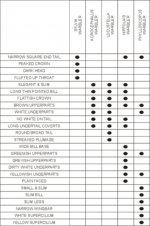Andrew
wibble wibble
I have just been reading up the different warblers in the Collins and simplified the characteristics to try and learn to differentiate these tricky birds. Here is what I came up with, I will appreciate any advice or corrections. Species in capitals are common British Warblers and the species listed have occurred in Britain.
SYLVIA WARBLERS.
Habitat : Scrubland, thickets, heathland, woodland.
Structure : Narrow square ended tail, peaked crowns, dark heads, fluffed up throats.
Species : GARDEN WARBLER, Barred Warbler, BLACKCAP, Orphean Warbler, LESSER WHITETHRAOT, Sardinian Warbler, Ruppell’s Warbler, COMMON WHITETHROAT, Spectacled Warbler, Subalpine Warbler, Desert Warbler, DARTFORD WARBLER, Marmora’s Warbler.
ACROCEPHALUS WARBLERS
Habitat : Open swamps or marshes in reed beds or small bushes.
Structure : Elegant slim build, long thin and pointed bills, flattish crowns. brownish upper parts, whitish underparts, no white on tails, long undertail coverts.
Species : SEDGE WARBLER, Aquatic Warbler, Moustached Warbler, EUROPEAN REED WARBLER, Marsh Warbler, Blyth’s Reed Warbler, Paddyfield Warbler, Great Reed Warbler, Thick Billed Warbler.
LOCUSTELLA WARBLERS
Habitat : Low vegetation such as tussocks often near water.
Structure : Similar to Acrocephalus, rounder and broader tails, streaked plumage, long undertail coverts.
Species : COMMON GRASSHOPPER WARBLER, Lanceolated Warbler, Palla’s Grasshopper Warbler, River Warbler, Savi’s Warbler
HIPPOLAIS WARBLERS
Habitat : Woods or in vegetation & bushes close to woods.
Structure : Closely related to Acrocephalus with squarer ended tails, wide base to bill, brownish or greenish grey upper parts, dirty white or yellowish white underparts, plain lores and face.
Species : Icterine Warbler, Melodious Warbler, Olivaceous Warbler, Booted Warbler (not plain faced), Syke's Warbler.
PHYLLOSCOPUS WARBLERS
Habitat : Woodlands with nests on ground.
Structure : Small, slim billed and legged, narrow & short square ended tail. Brownish or greenish upper parts, white or yellowish white underparts, some have narrow wing bar, pale white or yellow supercilium.
Species : WILLOW WARBLER, WOOD WARBLER, Western Bonelli’s Warbler, Eastern Bonelli’s Warbler, CHIFFCHAFF, (Siberian Chiffchaff), Iberian Chiffchaff, Dusky Warbler, Radde’s Warbler, Arctic Warbler, Greenish Warbler, Two-narred Greenish Warbler, Green Warbler, Yellow-browed Warbler, Hume’s Leaf Warbler, Pallas’s Warbler.
SYLVIA WARBLERS.
Habitat : Scrubland, thickets, heathland, woodland.
Structure : Narrow square ended tail, peaked crowns, dark heads, fluffed up throats.
Species : GARDEN WARBLER, Barred Warbler, BLACKCAP, Orphean Warbler, LESSER WHITETHRAOT, Sardinian Warbler, Ruppell’s Warbler, COMMON WHITETHROAT, Spectacled Warbler, Subalpine Warbler, Desert Warbler, DARTFORD WARBLER, Marmora’s Warbler.
ACROCEPHALUS WARBLERS
Habitat : Open swamps or marshes in reed beds or small bushes.
Structure : Elegant slim build, long thin and pointed bills, flattish crowns. brownish upper parts, whitish underparts, no white on tails, long undertail coverts.
Species : SEDGE WARBLER, Aquatic Warbler, Moustached Warbler, EUROPEAN REED WARBLER, Marsh Warbler, Blyth’s Reed Warbler, Paddyfield Warbler, Great Reed Warbler, Thick Billed Warbler.
LOCUSTELLA WARBLERS
Habitat : Low vegetation such as tussocks often near water.
Structure : Similar to Acrocephalus, rounder and broader tails, streaked plumage, long undertail coverts.
Species : COMMON GRASSHOPPER WARBLER, Lanceolated Warbler, Palla’s Grasshopper Warbler, River Warbler, Savi’s Warbler
HIPPOLAIS WARBLERS
Habitat : Woods or in vegetation & bushes close to woods.
Structure : Closely related to Acrocephalus with squarer ended tails, wide base to bill, brownish or greenish grey upper parts, dirty white or yellowish white underparts, plain lores and face.
Species : Icterine Warbler, Melodious Warbler, Olivaceous Warbler, Booted Warbler (not plain faced), Syke's Warbler.
PHYLLOSCOPUS WARBLERS
Habitat : Woodlands with nests on ground.
Structure : Small, slim billed and legged, narrow & short square ended tail. Brownish or greenish upper parts, white or yellowish white underparts, some have narrow wing bar, pale white or yellow supercilium.
Species : WILLOW WARBLER, WOOD WARBLER, Western Bonelli’s Warbler, Eastern Bonelli’s Warbler, CHIFFCHAFF, (Siberian Chiffchaff), Iberian Chiffchaff, Dusky Warbler, Radde’s Warbler, Arctic Warbler, Greenish Warbler, Two-narred Greenish Warbler, Green Warbler, Yellow-browed Warbler, Hume’s Leaf Warbler, Pallas’s Warbler.
Last edited:




